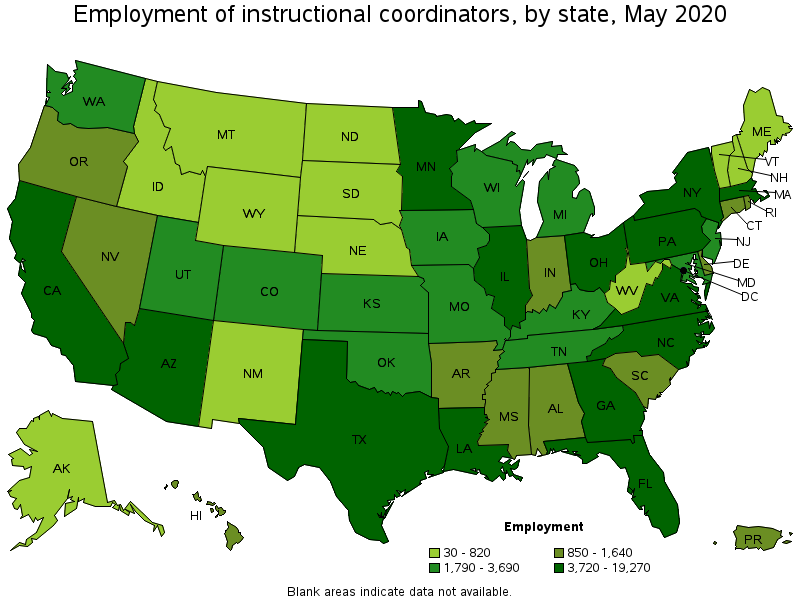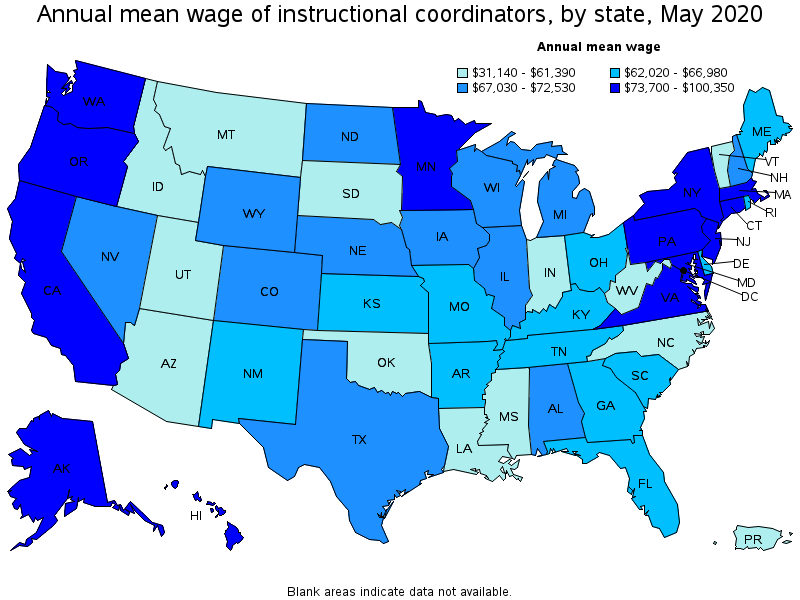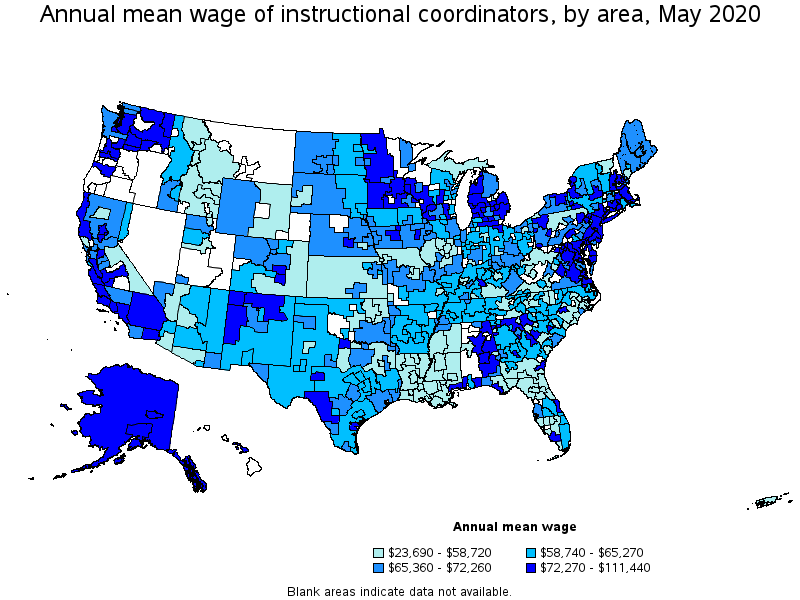An official website of the United States government
 United States Department of Labor
United States Department of Labor
Develop instructional material, coordinate educational content, and incorporate current technology into instruction in order to provide guidelines to educators and instructors for developing curricula and conducting courses. May train and coach teachers. Includes educational consultants and specialists, and instructional material directors.
Employment estimate and mean wage estimates for Instructional Coordinators:
| Employment (1) | Employment RSE (3) |
Mean hourly wage |
Mean annual wage (2) |
Wage RSE (3) |
|---|---|---|---|---|
| 174,900 | 1.6 % | $ 33.73 | $ 70,160 | 0.5 % |
Percentile wage estimates for Instructional Coordinators:
| Percentile | 10% | 25% | 50% (Median) |
75% | 90% |
|---|---|---|---|---|---|
| Hourly Wage | $ 18.88 | $ 24.86 | $ 32.20 | $ 41.39 | $ 50.79 |
| Annual Wage (2) | $ 39,270 | $ 51,720 | $ 66,970 | $ 86,100 | $ 105,650 |
Industries with the highest published employment and wages for Instructional Coordinators are provided. For a list of all industries with employment in Instructional Coordinators, see the Create Customized Tables function.
Industries with the highest levels of employment in Instructional Coordinators:
| Industry | Employment (1) | Percent of industry employment | Hourly mean wage | Annual mean wage (2) |
|---|---|---|---|---|
| Elementary and Secondary Schools | 83,400 | 1.01 | $ 34.65 | $ 72,070 |
| Colleges, Universities, and Professional Schools | 29,620 | 0.98 | $ 32.24 | $ 67,060 |
| Educational Support Services | 12,600 | 6.80 | $ 35.36 | $ 73,550 |
| Junior Colleges | 7,370 | 1.08 | $ 30.35 | $ 63,120 |
| State Government, excluding schools and hospitals (OEWS Designation) | 7,240 | 0.33 | $ 35.46 | $ 73,760 |
Industries with the highest concentration of employment in Instructional Coordinators:
| Industry | Employment (1) | Percent of industry employment | Hourly mean wage | Annual mean wage (2) |
|---|---|---|---|---|
| Educational Support Services | 12,600 | 6.80 | $ 35.36 | $ 73,550 |
| Business Schools and Computer and Management Training | 2,140 | 3.02 | $ 33.37 | $ 69,400 |
| Technical and Trade Schools | 1,840 | 1.47 | $ 31.20 | $ 64,890 |
| Junior Colleges | 7,370 | 1.08 | $ 30.35 | $ 63,120 |
| Elementary and Secondary Schools | 83,400 | 1.01 | $ 34.65 | $ 72,070 |
Top paying industries for Instructional Coordinators:
| Industry | Employment (1) | Percent of industry employment | Hourly mean wage | Annual mean wage (2) |
|---|---|---|---|---|
| Federal Executive Branch (OEWS Designation) | 2,420 | 0.12 | $ 47.75 | $ 99,320 |
| Electric Power Generation, Transmission and Distribution | 90 | 0.02 | $ 46.36 | $ 96,440 |
| Architectural, Engineering, and Related Services | 80 | 0.01 | $ 41.05 | $ 85,370 |
| Office Administrative Services | 180 | 0.04 | $ 39.63 | $ 82,440 |
| Motion Picture and Video Industries | 130 | 0.04 | $ 39.59 | $ 82,350 |
States and areas with the highest published employment, location quotients, and wages for Instructional Coordinators are provided. For a list of all areas with employment in Instructional Coordinators, see the Create Customized Tables function.

States with the highest employment level in Instructional Coordinators:
| State | Employment (1) | Employment per thousand jobs | Location quotient (9) | Hourly mean wage | Annual mean wage (2) |
|---|---|---|---|---|---|
| New York | 19,270 | 2.22 | 1.76 | $ 37.60 | $ 78,210 |
| California | 18,940 | 1.15 | 0.92 | $ 36.55 | $ 76,020 |
| Texas | 18,860 | 1.56 | 1.24 | $ 32.35 | $ 67,290 |
| Florida | 11,030 | 1.31 | 1.04 | $ 29.88 | $ 62,150 |
| Illinois | 7,220 | 1.28 | 1.02 | $ 32.62 | $ 67,850 |

States with the highest concentration of jobs and location quotients in Instructional Coordinators:
| State | Employment (1) | Employment per thousand jobs | Location quotient (9) | Hourly mean wage | Annual mean wage (2) |
|---|---|---|---|---|---|
| New York | 19,270 | 2.22 | 1.76 | $ 37.60 | $ 78,210 |
| District of Columbia | 1,470 | 2.13 | 1.70 | $ 48.24 | $ 100,350 |
| Louisiana | 3,730 | 2.07 | 1.65 | $ 25.55 | $ 53,140 |
| Rhode Island | 890 | 2.02 | 1.61 | $ 30.33 | $ 63,080 |
| Delaware | 850 | 1.99 | 1.58 | $ 31.42 | $ 65,350 |

Top paying states for Instructional Coordinators:
| State | Employment (1) | Employment per thousand jobs | Location quotient (9) | Hourly mean wage | Annual mean wage (2) |
|---|---|---|---|---|---|
| District of Columbia | 1,470 | 2.13 | 1.70 | $ 48.24 | $ 100,350 |
| Connecticut | 1,190 | 0.78 | 0.62 | $ 47.04 | $ 97,840 |
| Oregon | 1,230 | 0.68 | 0.54 | $ 41.54 | $ 86,390 |
| Virginia | 5,150 | 1.39 | 1.11 | $ 39.05 | $ 81,220 |
| New Jersey | 3,690 | 0.98 | 0.78 | $ 38.20 | $ 79,460 |

Metropolitan areas with the highest employment level in Instructional Coordinators:
| Metropolitan area | Employment (1) | Employment per thousand jobs | Location quotient (9) | Hourly mean wage | Annual mean wage (2) |
|---|---|---|---|---|---|
| New York-Newark-Jersey City, NY-NJ-PA | 16,360 | 1.85 | 1.47 | $ 38.61 | $ 80,310 |
| Los Angeles-Long Beach-Anaheim, CA | 6,690 | 1.15 | 0.91 | $ 36.97 | $ 76,890 |
| Dallas-Fort Worth-Arlington, TX | 5,740 | 1.60 | 1.27 | $ 31.84 | $ 66,220 |
| Chicago-Naperville-Elgin, IL-IN-WI | 5,590 | 1.28 | 1.02 | $ 33.95 | $ 70,610 |
| Washington-Arlington-Alexandria, DC-VA-MD-WV | 4,580 | 1.52 | 1.21 | $ 44.68 | $ 92,940 |
| Houston-The Woodlands-Sugar Land, TX | 4,260 | 1.43 | 1.14 | $ 33.97 | $ 70,650 |
| Philadelphia-Camden-Wilmington, PA-NJ-DE-MD | 4,110 | 1.52 | 1.21 | $ 36.29 | $ 75,490 |
| Atlanta-Sandy Springs-Roswell, GA | 4,060 | 1.54 | 1.23 | $ 31.14 | $ 64,770 |
| Boston-Cambridge-Nashua, MA-NH | 3,790 | 1.46 | 1.16 | $ 37.11 | $ 77,180 |
| Minneapolis-St. Paul-Bloomington, MN-WI | 3,390 | 1.83 | 1.46 | $ 37.42 | $ 77,830 |

Metropolitan areas with the highest concentration of jobs and location quotients in Instructional Coordinators:
| Metropolitan area | Employment (1) | Employment per thousand jobs | Location quotient (9) | Hourly mean wage | Annual mean wage (2) |
|---|---|---|---|---|---|
| Ithaca, NY | 620 | 13.53 | 10.76 | $ 38.14 | $ 79,340 |
| Lawrence, KS | 290 | 6.48 | 5.15 | $ 28.66 | $ 59,620 |
| Victoria, TX | 190 | 5.19 | 4.13 | $ 31.14 | $ 64,780 |
| Wichita Falls, TX | 270 | 5.02 | 3.99 | $ 34.77 | $ 72,320 |
| Champaign-Urbana, IL | 400 | 4.22 | 3.36 | $ 26.67 | $ 55,460 |
| Corvallis, OR | 150 | 4.16 | 3.31 | (8) | (8) |
| Greenville, NC | 300 | 4.11 | 3.27 | $ 28.17 | $ 58,580 |
| Topeka, KS | 390 | 3.73 | 2.97 | $ 33.09 | $ 68,820 |
| McAllen-Edinburg-Mission, TX | 890 | 3.42 | 2.72 | $ 33.22 | $ 69,100 |
| Tallahassee, FL | 570 | 3.38 | 2.69 | $ 24.86 | $ 51,710 |

Top paying metropolitan areas for Instructional Coordinators:
| Metropolitan area | Employment (1) | Employment per thousand jobs | Location quotient (9) | Hourly mean wage | Annual mean wage (2) |
|---|---|---|---|---|---|
| New Haven, CT | 240 | 0.89 | 0.71 | $ 53.58 | $ 111,440 |
| Warner Robins, GA | (8) | (8) | (8) | $ 53.27 | $ 110,800 |
| Riverside-San Bernardino-Ontario, CA | 1,450 | 0.98 | 0.78 | $ 50.00 | $ 104,000 |
| Bridgeport-Stamford-Norwalk, CT | 170 | 0.44 | 0.35 | $ 49.77 | $ 103,510 |
| Hartford-West Hartford-East Hartford, CT | 560 | 1.02 | 0.81 | $ 46.24 | $ 96,190 |
| Salem, OR | 260 | 1.56 | 1.24 | $ 45.10 | $ 93,810 |
| Danbury, CT | (8) | (8) | (8) | $ 44.83 | $ 93,250 |
| Fresno, CA | 350 | 0.94 | 0.75 | $ 44.79 | $ 93,150 |
| Hanford-Corcoran, CA | 50 | 1.23 | 0.98 | $ 44.69 | $ 92,960 |
| Washington-Arlington-Alexandria, DC-VA-MD-WV | 4,580 | 1.52 | 1.21 | $ 44.68 | $ 92,940 |
Nonmetropolitan areas with the highest employment in Instructional Coordinators:
| Nonmetropolitan area | Employment (1) | Employment per thousand jobs | Location quotient (9) | Hourly mean wage | Annual mean wage (2) |
|---|---|---|---|---|---|
| Piedmont North Carolina nonmetropolitan area | 380 | 1.56 | 1.24 | $ 29.27 | $ 60,870 |
| Central Kentucky nonmetropolitan area | 370 | 2.17 | 1.73 | $ 30.81 | $ 64,090 |
| Kansas nonmetropolitan area | 370 | 0.97 | 0.77 | $ 25.88 | $ 53,820 |
| Northeast Mississippi nonmetropolitan area | 310 | 1.39 | 1.11 | $ 22.22 | $ 46,210 |
| Southern Ohio nonmetropolitan area | 300 | 2.04 | 1.62 | $ 31.91 | $ 66,380 |
Nonmetropolitan areas with the highest concentration of jobs and location quotients in Instructional Coordinators:
| Nonmetropolitan area | Employment (1) | Employment per thousand jobs | Location quotient (9) | Hourly mean wage | Annual mean wage (2) |
|---|---|---|---|---|---|
| Northeast Louisiana nonmetropolitan area | 200 | 3.23 | 2.57 | $ 27.25 | $ 56,680 |
| Central Louisiana nonmetropolitan area | 200 | 2.63 | 2.10 | $ 23.90 | $ 49,700 |
| North Coast Region of California nonmetropolitan area | 230 | 2.39 | 1.90 | $ 37.63 | $ 78,260 |
| Hawaii / Kauai nonmetropolitan area | 210 | 2.28 | 1.81 | (8) | (8) |
| Northern Vermont nonmetropolitan area | 140 | 2.21 | 1.76 | $ 28.13 | $ 58,500 |
Top paying nonmetropolitan areas for Instructional Coordinators:
| Nonmetropolitan area | Employment (1) | Employment per thousand jobs | Location quotient (9) | Hourly mean wage | Annual mean wage (2) |
|---|---|---|---|---|---|
| Northeast Alabama nonmetropolitan area | (8) | (8) | (8) | $ 39.14 | $ 81,410 |
| North Georgia nonmetropolitan area | 210 | 1.28 | 1.02 | $ 38.59 | $ 80,270 |
| Northern New Mexico nonmetropolitan area | 50 | 0.59 | 0.47 | $ 38.38 | $ 79,830 |
| Central New Hampshire nonmetropolitan area | 110 | 1.21 | 0.96 | $ 38.04 | $ 79,130 |
| North Coast Region of California nonmetropolitan area | 230 | 2.39 | 1.90 | $ 37.63 | $ 78,260 |
These estimates are calculated with data collected from employers in all industry sectors, all metropolitan and nonmetropolitan areas, and all states and the District of Columbia. The top employment and wage figures are provided above. The complete list is available in the downloadable XLS files.
The percentile wage estimate is the value of a wage below which a certain percent of workers fall. The median wage is the 50th percentile wage estimate—50 percent of workers earn less than the median and 50 percent of workers earn more than the median. More about percentile wages.
(1) Estimates for detailed occupations do not sum to the totals because the totals include occupations not shown separately. Estimates do not include self-employed workers.
(2) Annual wages have been calculated by multiplying the hourly mean wage by a "year-round, full-time" hours figure of 2,080 hours; for those occupations where there is not an hourly wage published, the annual wage has been directly calculated from the reported survey data.
(3) The relative standard error (RSE) is a measure of the reliability of a survey statistic. The smaller the relative standard error, the more precise the estimate.
(8) Estimate not released.
(9) The location quotient is the ratio of the area concentration of occupational employment to the national average concentration. A location quotient greater than one indicates the occupation has a higher share of employment than average, and a location quotient less than one indicates the occupation is less prevalent in the area than average.
Other OEWS estimates and related information:
May 2020 National Occupational Employment and Wage Estimates
May 2020 State Occupational Employment and Wage Estimates
May 2020 Metropolitan and Nonmetropolitan Area Occupational Employment and Wage Estimates
May 2020 National Industry-Specific Occupational Employment and Wage Estimates
Last Modified Date: March 31, 2021